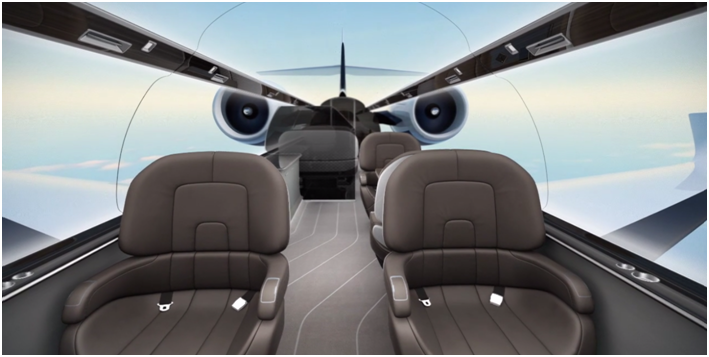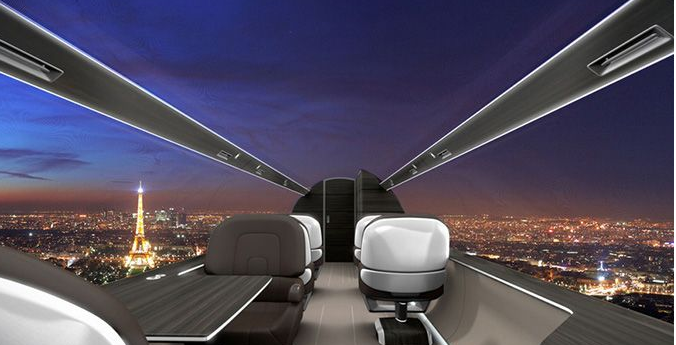Completely Transparent Plane Would Let Passengers See World around Them
 Do you love flying, or looking out of windows while in plan. Get ready, within a decade you will be able to fly in a plane without windows … In fact completely transparent i.e. you can enjoy the outside view as a whole. Isn’t it amazing to travel in sky exactly like flying with no cabinet around? Well this imagination will soon be reality with an initiative taken by UK-based tech innovation company Centre for Process Innovation. The company will design a plane using OLEDs that will give transparent effect to the cabinet once activated. A comprehensive overview of the innovation is as follows:
Do you love flying, or looking out of windows while in plan. Get ready, within a decade you will be able to fly in a plane without windows … In fact completely transparent i.e. you can enjoy the outside view as a whole. Isn’t it amazing to travel in sky exactly like flying with no cabinet around? Well this imagination will soon be reality with an initiative taken by UK-based tech innovation company Centre for Process Innovation. The company will design a plane using OLEDs that will give transparent effect to the cabinet once activated. A comprehensive overview of the innovation is as follows:
Instead of windows, the plane would have high-definition, flexible screens to show what’s happening outside, as it soars through the air.
Hope you’re not too attached to looking out the windows when you fly—the designers of tomorrow’s airplanes seem intent on getting rid of them. A Paris design firm recently made waves when it released its concept for a sleek, solar paneled, windowless passenger jet. Before that, Airbus proposed eschewing windows and building its cabins out of transparent polymers. Now, the Center for Process Innovation has floated its own windowless plane concept, and it’s attracting plenty of attention, too.
Practically, there are no actual windows in the plane’s passenger section; the displays create the illusion that the cabin walls are transparent. The concept for windowless aircrafts with displays isn’t entirely new. A Paris-based company has a similar in development, and there’s also a design in the works for a windowless jet. But CPI believes the vision could become a reality within 10 years. The imaging you’d see from the panels would come from mounted cameras outside of the aircraft that the developers say could offer an unobstructed panoramic view, meaning no visible wings or engines. Users could adjust the settings and use the displays for in-flight services. The plane would use OLED screens (a high-end, thin-film display technology) with protective coatings made to preserve the displays for its lifetime. Passengers would also be able to see and set their screen to show a live stream of outside surroundings from a completely different portion of the plane.
Ideology of this innovation
Normally a very simple idea drives a great innovation, same thing we can say in this case. “Replacing the mechanical housing with OLEDs inside the cabin and installed cameras outside delivering live view inside” is the basic idea.
 The idea is to apply the latest advancements in optoelectronics to enhance the travelers’ experience and elegantly cut costs. Removing the windows eliminates heavy housings, which significantly reduces the plane’s weight. Less weight = less fuel. And according to the company taking the lead on this ambitious project, for every 1% reduction in weight, there’s 0.75% in fuel savings. This cost savings would presumably trickle down to passengers. Cameras mounted on the plane’s exterior — and powered by solar panels — would capture a panoramic view of the sky (or any broad canvas) and project it onto OLED screens for the passengers. And it wouldn’t be limited to what’s outside the plane. Going for a long voyage over the Atlantic? How about a panoramic view of Venice Beach or the Grand Canyon?
The idea is to apply the latest advancements in optoelectronics to enhance the travelers’ experience and elegantly cut costs. Removing the windows eliminates heavy housings, which significantly reduces the plane’s weight. Less weight = less fuel. And according to the company taking the lead on this ambitious project, for every 1% reduction in weight, there’s 0.75% in fuel savings. This cost savings would presumably trickle down to passengers. Cameras mounted on the plane’s exterior — and powered by solar panels — would capture a panoramic view of the sky (or any broad canvas) and project it onto OLED screens for the passengers. And it wouldn’t be limited to what’s outside the plane. Going for a long voyage over the Atlantic? How about a panoramic view of Venice Beach or the Grand Canyon?
CPI has made some pretty substantial claims about what this sort of technology could do for the flight industry. For starters, the plane walls would be thinner, more lightweight and stronger than what we have now. It’s also cheaper, CPI said, which could lead to less costly flights for consumers. According to its calculations, each time plane weight reduces 1%, there’s a 0.75% savings in fuel cost, so the passenger, manufacturer and the airline will save money. CPI has made some pretty substantial claims about what this sort of technology could do for the flight industry. For starters, the plane walls would be thinner, more lightweight and stronger than what we have now. It’s also cheaper, CPI said, which could lead to less costly flights for consumers. According to its calculations, each time plane weight reduces 1%, there’s a 0.75% savings in fuel cost, so the passenger, manufacturer and the airline will save money.
If a window seat is enough to make you nervous on a flight, you might want to avoid a new kind of plane that could fly in a decade. UK-based tech Innovation Company CPI hopes to be among the first to design a windowless aircraft.
Meet the Innovators …
This intriguing and thought-provoking new aviation concept is presented by, a Paris-based design company’s Technicon Design. In year 2014, the firm snared an award for its IXION windowless jet concept. It was remarkably similar; it also sought to use cameras mounted outside the plane to provide a “360-degree view” of the scenery, projected on high res screens inside the cabin. Technicon also noted that this would allow the plane’s frame to be more flexible and lightweight.
A couple years before that, commercial airplane behemoth Airbus floated the idea of doing away with windows in its 2050 future airliner designs. The company suggested an embrace of biomimicry, and turning the cabin into a sort of terrifying/awesome airborne hive cluster. A bio-polyer membrane would control light, humidity and temperature and could become transparent or opaque at the push of a button, eliminating the need for windows. Airbus is still on its windowless tear, by the way—it recently filed a patent for windowless cockpits.
“We can make transistors that are flexible, but if we can make OLEDs that are flexible, that gives us a lot of potential in the market because we can print OLEDs on to packaging,” said CPI’s Dr. Jon Helliwell. But the futuristic technology doesn’t end there; the images displayed would also change in accordance with the passenger’s head movements. If CPI are successful in developing OLED technology, ultimately it could also lead to “smart packaging” for pharmaceuticals or food which would provide gadgets with important information, such as when the produce is spoiling.
Conclusion…
For the claustrophobics out there, a plane without windows may sound like a total nightmare, but the idea isn’t to take away your view of the world as you soar through the air, it’s to enhance it. In case, you don’t fancy watching the skies, you can always flick over the usual in-flight entertainment. So technology is ready to add a new chapter in aerospace engineering coupled with technological advancements and futuristic enhancements.






